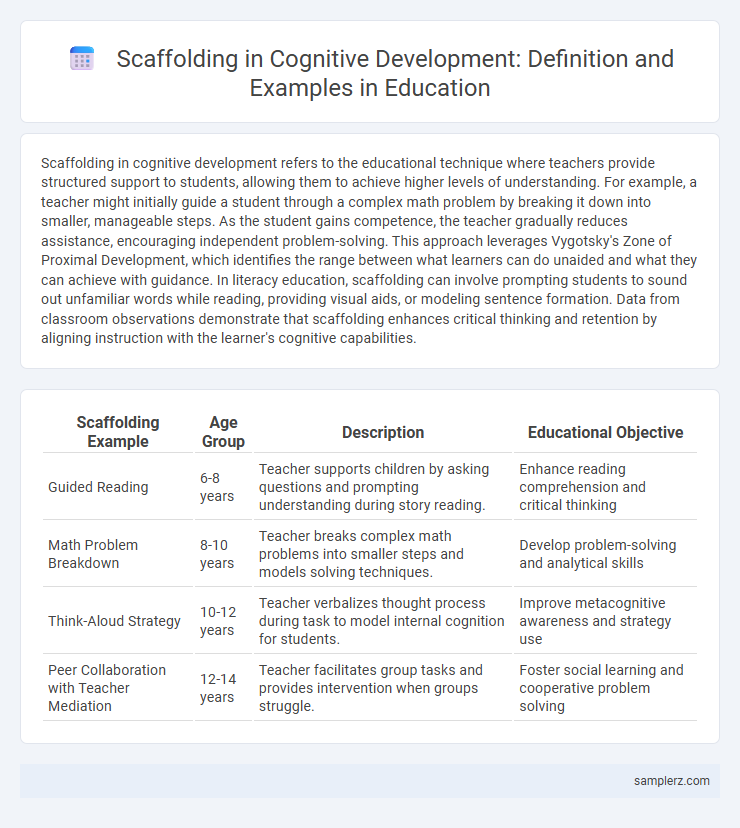Scaffolding in cognitive development refers to the educational technique where teachers provide structured support to students, allowing them to achieve higher levels of understanding. For example, a teacher might initially guide a student through a complex math problem by breaking it down into smaller, manageable steps. As the student gains competence, the teacher gradually reduces assistance, encouraging independent problem-solving. This approach leverages Vygotsky's Zone of Proximal Development, which identifies the range between what learners can do unaided and what they can achieve with guidance. In literacy education, scaffolding can involve prompting students to sound out unfamiliar words while reading, providing visual aids, or modeling sentence formation. Data from classroom observations demonstrate that scaffolding enhances critical thinking and retention by aligning instruction with the learner's cognitive capabilities.
Table of Comparison
| Scaffolding Example | Age Group | Description | Educational Objective |
|---|---|---|---|
| Guided Reading | 6-8 years | Teacher supports children by asking questions and prompting understanding during story reading. | Enhance reading comprehension and critical thinking |
| Math Problem Breakdown | 8-10 years | Teacher breaks complex math problems into smaller steps and models solving techniques. | Develop problem-solving and analytical skills |
| Think-Aloud Strategy | 10-12 years | Teacher verbalizes thought process during task to model internal cognition for students. | Improve metacognitive awareness and strategy use |
| Peer Collaboration with Teacher Mediation | 12-14 years | Teacher facilitates group tasks and provides intervention when groups struggle. | Foster social learning and cooperative problem solving |
Introduction to Scaffolding in Cognitive Development
Scaffolding in cognitive development involves providing tailored support to learners, enabling them to accomplish tasks just beyond their current abilities. This instructional strategy leverages guided interaction, such as hints or modeling, to progressively build independent problem-solving skills. Effective scaffolding adjusts the level of assistance as the learner's competence increases, fostering deeper understanding and cognitive growth.
Theoretical Foundations of Scaffolding
Scaffolding in cognitive development is rooted in Vygotsky's Zone of Proximal Development (ZPD), emphasizing guided learning through social interaction and expert support. This theoretical foundation highlights the tailored assistance provided by educators or peers to bridge the gap between a learner's current ability and potential competence. Effective scaffolding gradually shifts responsibility to the learner, fostering independence and enhancing problem-solving skills.
Scaffolding in Early Childhood Learning
Scaffolding in early childhood learning involves guided support where educators provide tailored assistance to help children grasp new concepts, gradually reducing help as competence increases. Techniques such as modeling problem-solving steps and asking open-ended questions promote cognitive development by encouraging active thinking and self-regulation. This approach accelerates skill acquisition in areas like language, numeracy, and social understanding within critical developmental periods.
Role of Teachers in Educational Scaffolding
Teachers play a crucial role in educational scaffolding by providing tailored support that matches the student's current cognitive abilities and gradually withdrawing assistance as competence increases. Effective scaffolding involves breaking complex tasks into manageable steps, offering hints, asking guiding questions, and modeling problem-solving strategies to enhance understanding and skill acquisition. This dynamic interaction fosters independent learning and critical thinking, promoting cognitive development in diverse classroom settings.
Classroom Techniques for Effective Scaffolding
Effective scaffolding in cognitive development involves techniques such as modeling problem-solving strategies, providing guided practice, and using questioning to promote critical thinking. Teachers can break complex tasks into manageable steps, offering support tailored to each student's zone of proximal development to enhance learning efficiency. Collaborative activities and timely feedback further reinforce understanding and foster independent mastery in the classroom.
Scaffolding Strategies in Literacy Instruction
Scaffolding strategies in literacy instruction include modeling fluent reading, providing guided practice through shared reading, and using questioning techniques to enhance comprehension and critical thinking. Teachers break down complex texts into manageable parts, gradually increasing difficulty as students build confidence and skills. Interactive discussions and targeted feedback support students' ability to decode language, expand vocabulary, and improve narrative understanding.
Collaborative Scaffolding Among Peers
Collaborative scaffolding among peers enhances cognitive development by enabling students to share knowledge and problem-solving strategies during group activities, fostering deeper understanding through peer interaction. This approach leverages Vygotsky's Zone of Proximal Development, where more knowledgeable peers guide others in achieving tasks they could not complete independently. Studies in educational psychology highlight that peer scaffolding promotes critical thinking, communication skills, and metacognitive awareness in classroom settings.
Technology-Assisted Scaffolding in Education
Technology-assisted scaffolding enhances cognitive development by providing adaptive learning platforms that tailor support to individual student needs, such as intelligent tutoring systems and interactive educational software. These tools promote gradual skill acquisition by offering timely feedback, hints, and prompts that bridge gaps in understanding. Integrating technologies like virtual reality and gamified learning environments further supports complex problem-solving and critical thinking through immersive, scaffolded experiences.
Assessing the Impact of Scaffolding on Student Outcomes
Scaffolding in cognitive development involves providing tailored support to students that gradually diminishes as their competence increases, enhancing learning effectiveness. Research shows that assessing the impact of scaffolding on student outcomes reveals significant improvements in problem-solving skills, critical thinking, and knowledge retention. Effective scaffolding strategies lead to higher academic achievement by enabling students to build on prior knowledge and develop independent learning abilities.
Challenges and Best Practices in Implementing Scaffolding
Scaffolding in cognitive development faces challenges such as balancing support without fostering dependency, adapting to diverse learner needs, and ensuring timely withdrawal of assistance to promote autonomy. Best practices include individualized assessment, using formative feedback to adjust support levels, and fostering metacognitive skills to enable learners to become self-regulated. Effective scaffolding requires continuous teacher training and the incorporation of culturally responsive strategies to enhance engagement and comprehension.

example of Scaffolding in cognitive development Infographic
 samplerz.com
samplerz.com